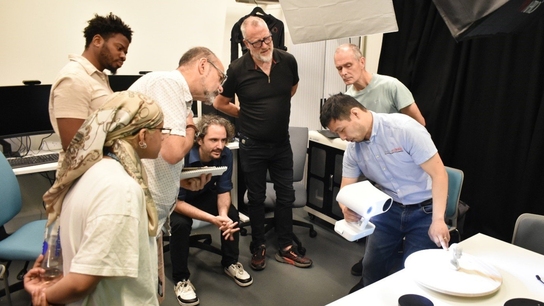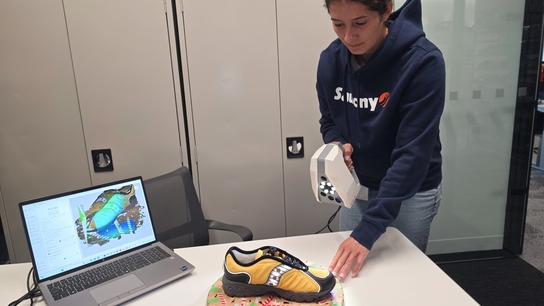Using 3D scanning to make rubbings of 3000-year-old oracle bones
Challenge: Rubbing is the traditional method used for reproducing (in ink) the characters and symbols inscribed on oracle bones. But this process has some serious limitations, including the need to make physical contact with and possibly damage these priceless artifacts.
Solution: Artec Space Spider, Artec Studio
Results: Using 3D scanning technology, digital rubbings are made for oracle bone inscriptions, to achieve high-precision digital archives of oracle bone surface details. This process is 100% safe for the bones, and now researchers can easily produce and share the resulting 3D models with colleagues and others. As well, lifelike AR/VR virtual museum exhibits can be made from the same 3D scans.

Yinxu National Archaeological Site Park (Photo: 163.com)
The Yinxu oracle bones
Oracle bone inscriptions are the earliest known systematic characters in China and East Asia, with a history of more than 3,000 years. The oracle bones were mainly unearthed in the area of Xiaotun Village, Anyang, Henan Province. Historically called Yin, Anyang was the capital of the late Shang Dynasty. Oracle bone inscriptions are usually engraved on tortoise shells or animal bones, and most of their content is related to divination by the Yin and Shang royal families.
Today, oracle bone research has become a subject of great interest around the world. At present, more than 150,000 oracle bones have been unearthed, about 2,500 characters have been identified, and about 2,000 characters have yet to be deciphered. There are more than 500 Chinese and foreign scholars engaged in oracle bone inscriptions, with more than 3,000 monographs and papers published. The study of oracle bones has also promoted the development of various disciplines such as linguistics, history, ethnology, astronomy, meteorology, agriculture, medicine, historical geography, and archaeology.
On Dec. 26, 2017, these oracle bones were successfully included in the UNESCO Memory of the World Register, a compendium of the world’s documentary heritage.

Chiselling an oracle bone (Courtesy of the CCTV documentary “the Dynasty of Oracle Bones”)
The ancient method of inscription rubbing
Since the discovery of oracle bone inscriptions by epigrapher Wang Yirong during the Guangxu period of the Qing Dynasty, oracle bone inscription researchers and enthusiasts have faced a challenge that is crucial to solve: how to transcribe, disseminate, and share the textual information on oracle bones without causing damage to the oracle bones themselves.
The mainstream traditional technique used in academia is the rubbing method, an ancient traditional technique used in China. Before the birth of modern technology, rubbing made it possible to preserve the original appearance and details of the object to the best possible extent. In addition, repeated rubbings obtain multiple identical rubbings, which is comparable to printing. The ability to make rubbings has been an essential skill for oracle researchers.

Making a rubbing (Courtesy of the CCTV documentary “the Dynasty of Oracle Bones”)
When making rubbings, you need to apply soaked paper material onto the oracle bones and tap lightly with a brush to push the paper down into the engravings. When the paper is slightly dry, ink is evenly applied. The paper is then peeled off to form a black and white rubbing.
Although rubbing is the most mainstream transcription technique in the academic world, it has many limitations. For example, the oracle bone must be touched while making rubbings, which might cause damage to the object. In addition, the results of the final rubbing are influenced by temperature and humidity conditions, as well as the operator’s skill level.
Introducing 3D scanning
Dr. Li Zongkun is a chair professor and PhD supervisor in Humanities at Peking University, which has a collection of over 4,000 oracle bones. Dr. Li, devoted to the research and teaching classes on oracle bones and palaeography, passes the skills of rubbing on to his students using his extensive first-hand experience. However, this technique is subject to some practical limitations and demands physical contact with the bones.
One day, he came across 3D technology and decided to take a closer look: to see how well it could apply to his work with oracle bones.

Peking University
To test his idea, Dr. Li asked a 3D scanning specialist from trusted Artec 3D reseller ASAHI-3D to scan an oracle bone in the university’s collection using Artec Space Spider. As Artec partners in China, ASAHI-3D has worked in close cooperation with Peking University and offered many 3D scanning solutions.

For scanning: an inscribed bone used for divination. (Photo: Peking University)
The object selected for scanning was an inscribed bone that was used for divination – 31.1 cm long and 16.1 cm wide, the bone is part of a long-treasured collection in the School of Archaeology and Literature of Peking University, dating back to the late Shang dynasty (more than 3,000 years ago).
There are 45 characters on the front, and one character that has almost disappeared on the back, epitomizing the oracle bone inscriptions of the Shang dynasty. This bone can also be pieced together with another small bone (Collection of Oracle Bones, No. 11574) now in the National Library. The two divination scripts on the bone are both related to war.

Dr. Li and a specialist from ASAHI-3D (Courtesy of the CCTV documentary “the Dynasty of Oracle Bones”)
ASAHI-3D chose Artec Space Spider to capture both sides of the oracle bone. Jiao Chunliang, Technical Director of ASAHI-3D, said, “Artec Space Spider is an amazing 3D scanner, which has played a key role in many scanning projects. Precise capture is possible even without any targets or preparation, making a lifelike digital replica well within reach. Zero contact ensures safety for cultural relics. From a cloisonné vase in the early Qing dynasty to Terracotta Warriors, reverse engineering small objects can be a walk in the park. Space Spider has made many brilliant models possible.”

Artec Space Spider scanning the oracle bone (Courtesy of the CCTV documentary “the Dynasty of Oracle Bones”)
An improved process
Space Spider can start capturing data in just one click, with no targets required. The specialist simply needs to point the scanner at the bone from a distance of 20-30 cm. While the scanner is moved around the bone, the captured 3D surface data is displayed on the computer screen in real time.
After the front of the bone is scanned, the bone is turned over and scanned using the same process; the scanning session takes only a few minutes from start to finish.

Artec Studio screenshot showing scanning of the oracle bone (Courtesy of the CCTV documentary “the Dynasty of Oracle Bones”)
The scan data is then processed in Artec Studio. After outlier removal, the front and back scans of the oracle bone are aligned, so as to make a complete model. Next, global registration and fusion algorithms are run to create a final mesh model.
The oracle bone has an extensive amount of surface detail, which can prove to be a challenge from a texture-reproduction perspective. However, the photorealistic texture feature in Artec Studio fully meets the requirements of the client, and without the need for any other software, the original color was replicated using hi-res textures captured using various photogrammetry equipment (e.g. DSLR cameras). The final result: a complete, lifelike model of the oracle bone that is fully suitable for research and a range of other applications.

A close-up of the color model
After processing the scans in Artec Studio, the 3D model can be exported to third-party software, such as Geomagic or ZBrush, for additional processing. Following the scanning process, the scanning specialist was able to present complete information on the oracle bone with the digital rubbing made from the scan data.
Using a different method of data capture from the past, a 3D-scanned digital rubbing of oracle bones no doubt offers an abundance of possibilities for digital archival and museum exhibitions.

A digital rubbing (left), compared to Artec Space Spider scan data
Working with Space Spider means no spray or targets are required for capturing oracle bones, which means zero risk for these priceless artifacts. The total scanning process takes only a few minutes, and Space Spider’s high-quality data and Artec Studio’s efficient algorithms together ensure a relatively small file size, which further reduces scan processing time. As a result, high-resolution color 3D models are produced quickly and easily.
Countless opportunities
Regarding the use of 3D scanning in heritage preservation, the client explained, “3D scanning technology is able to satisfy the rising demand for digitization of cultural relics. It has proven to be a reliable tool for archiving and restoring valuable heritage, and it has inspired new ideas and approaches. This is something innovative that we need to pay more attention to.”
Jiao Chunliang from ASAHI-3D added, “We are honored to be part of the oracle bone scanning process. This is a brand new way of recording history and is of much significance to heritage preservation and digital archiving. We hope that, in technical terms, the whole process is effective and the clients are pleased. As long as we have captured all the data, it may be possible to showcase the 3D models of oracle bones in a VR or AR environment, bringing cultural heritage within reach of students all over the country.”




